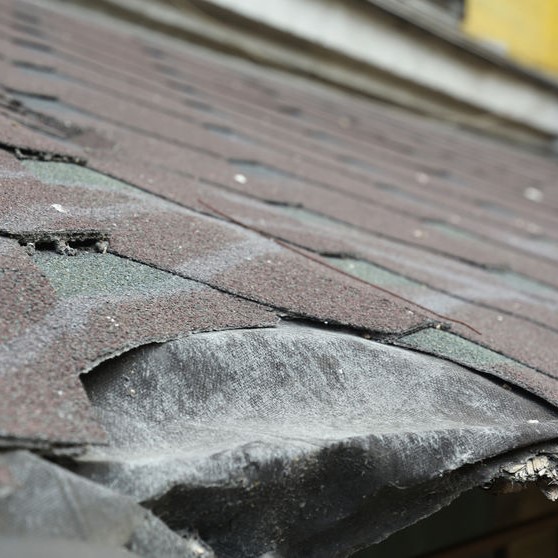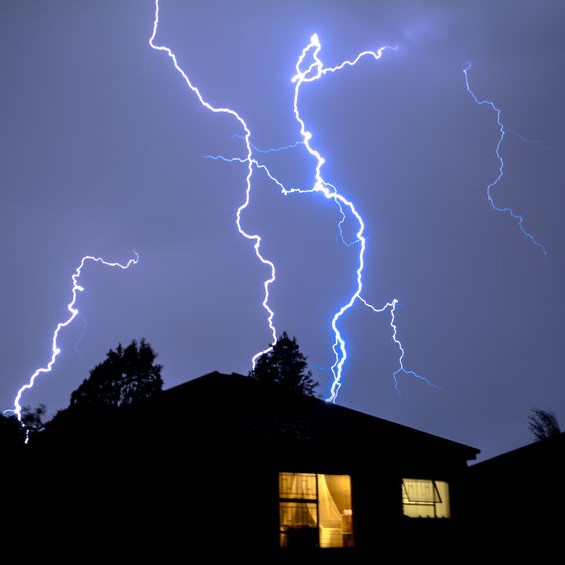
How do I know if my roof has storm damage?
While there isn’t an official declared area of ‘tornado alley’, ask any lifelong Missourian if the state of Missouri is in that area and they’ll tell you yes. Some of the folks you ask just might tell you, even show you the storm damage roofs they have experienced, and how they had to file an insurance claim.
From wind damage to roof to hail damage roof, this state has had it share. Then there are new homeowners or those new to the area they aren’t sure what constitute the need to file a storm damage roof claim. Those are the folks that this article is geared toward, but even the most experienced homeowner may learn something too – keep on reading!
As a homeowner, your first task after a storm passes is to check your home from top to bottom, inside and out. Even if you don’t see any obvious signs inside like water dripping from the ceiling or down the wall, check the roof.
We don’t recommend a homeowner climb up on the roof, but with binoculars, you can see if there is possible damage. Any possible sign of a storm damage roof or other areas around your home, call a professional contractor. Damaging wind happens at 50mph or higher and will accompany severe thunderstorms. They are sometimes referred to as “straight line” and accused of being a tornado. The signs your roof sustained wind damage would be:
- Missing roof shingles.
- Asphalt granule loss is apparent by “bald” shingles.
- Water penetration on the ceilings and walls inside your home.
- Loose debris around your house like lawn furniture, yard waste, etc.
Hail will form inside strong thunderstorms when the temperature hits 32°F and lower, which is the same as when snow occurs. Hail stones are compacted ice that can cause hailstorm damage roofs with stones measuring as small as 1 inch and larger. Signs of you have a hail damage roof includes:
- Damaged or Missing Shingles
- Broken or clogged gutters or downspouts.
- Ice Dams
Can heavy rain damage a roof?
Heavy rainstorms wear roofing shingles and other elements on the roof, like the chimney or vent pipes, down, weakening, even destroying them. The damage can result in lost shingles and water penetration under the shingles to the decking and underlayment.
As the water penetrates the roof decking and underlayment, it can compromise your home’s structural integrity if not caught and repaired quickly. That excessive moisture will lead to mildew, mold, and rot, making the structure unhealthy and stability unsafe. If these issues aren’t addressed promptly, your insurance company could deny any storm damage roof claim or any other storm damage claims.
A sloping roof has special challenges in protecting it from possible rain damage because water will collect and pool where the roof angles connect. A recommended solution beforehand is to have a professional roofer install waterproofing that will protect your roof from this moisture damage.
Another recommended solution is keeping a regular routine of gutter cleaning around your home. Any visual indications of gutter runs coming loose, fasten them, and replace any gutter runs that have developed rust holes. These are things that can prevent possible roof damage and the insurance company may see as homeowner neglect and deny any storm damage roof claims.
Does insurance cover storm damage to roof?
The best and easiest way to know what your homeowner’s insurance coverage includes is to either review the policy yourself or contact your insurance agent. Storm damage roof coverage could be affected by the age of the roof, where you live, and other factors that will be specified in your policy.
Storm damage roof coverage is included in most homeowner insurance policies if determined it was unpreventable like “acts of God”, fire, or vandalism. Hail, rain, and wind are covered by homeowner’s insurance policies too but there could be determining factors that would have a storm damage roof claim denied.
Does homeowners cover storm damage?
Certain storm damage roof causes are covered by homeowner’s insurance. This includes any hail, lighting, or wind damage. What isn’t covered in most policies is damage caused by earthquakes and flood. These are exceptions and stipulations that are detailed in your homeowner’s insurance policy and the time to review that is before you have storm damage roof or other damages cause by storms.
How do storm damage insurance claims work?
If you have storm damage roof issues, have a professional roofing contractor inspect your roof and give you a written estimate. Ask them to take pictures while on the rooftop and take pictures of your own that you can do safely from the ground.
Then call your insurance company and file the claim. An insurance adjuster will be assigned to your claim and schedule an appointment with you to inspect your roof and home. Ask the roofing contractor to be there at the same time to assure the adjuster sees all the damage they found. Remember, the roofing contractor is on your side.
Once the adjuster has approved the claim, you’ll get a notice what they are offering minus the deductible you’re responsible for paying. If you approve the amount, they’ll cut you a check. If you don’t agree with the amount, then you have the right to dispute and hire an independent adjuster to review the claim and reinspect your storm damage roof and other damages.

Why is my roof leaking when it rains?
What is the most common cause of roof leaks?
There can be any number of reasons a roof begins to leak or leaks every time it rains. A professional roofing inspection would be the best way to find out if any of the following common possibilities are the cause:
- Plumbing: Storm damage roof leaks aren’t the only possibility. Plumbing can cause roof leaks from the flashing, chimney, or vent pipe.
- Chimneys: As we just mentioned, a chimney is often one of the most common cause of roof leaks. The rain could be coming through the chimney because the chimney cap or flue isn’t working correctly. It can also be the angle flashing around the chimney where it meets the roof.
- Skylights: A common source of roof leak other than storm damage roof leak are skylights. This can be from the skylights being damaged, installed wrong, or has simply gotten old and unreliable in weather conditions.
- Damaged or aging shingles: Asphalt roofing shingles age over time, dry out and no longer do the job they were installed to do – keeping your home dry and safe. When a hard rain comes, if the shingles are too old, the roof will leak. A storm damage roof claim may or may not be approved by your insurance company if the adjuster finds your roof is aged beyond reliability.
- Corroded Metal: The metal fasteners and flashing on a metal roof will corrode over time, becoming rusted or with the temperature they contract and expand, becoming loose. Once they become loose enough, they allow the roof to leak.
- Attic Condensation: When the attic doesn’t have sufficient ventilation, it will build up condensation and that moisture with hot air will collect in the attic and enough of it will begin leaking through the ceiling.
You pay your homeowner’s insurance premiums for protection. It is your right to file a storm damage roof claim or any type of storm damage claim. It is to your benefit to make sure you have an issue worthy of a claim though and that is where roofing contractors can help. Call 816-896-4195 today for storm damage repair in Grain Valley and Kansas City, MO.